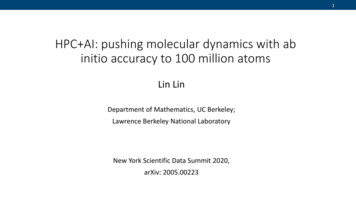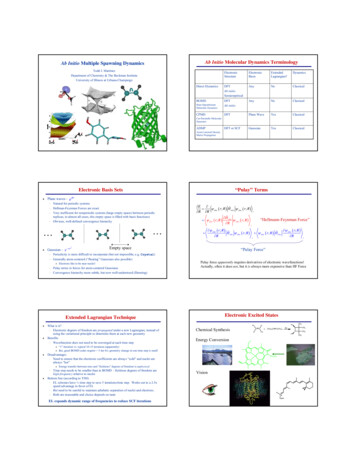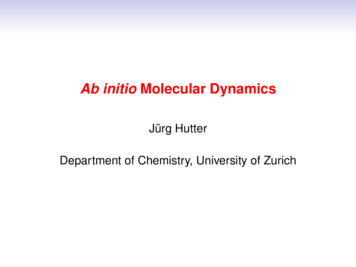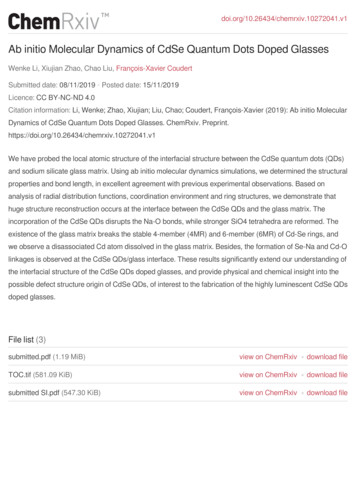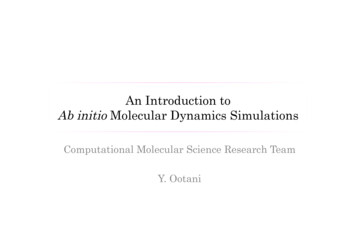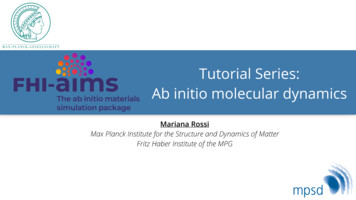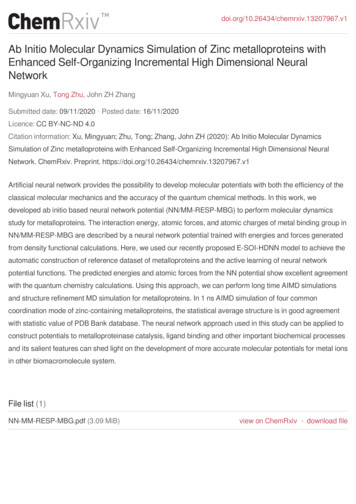
Transcription
doi.org/10.26434/chemrxiv.13207967.v1Ab Initio Molecular Dynamics Simulation of Zinc metalloproteins withEnhanced Self-Organizing Incremental High Dimensional NeuralNetworkMingyuan Xu, Tong Zhu, John ZH ZhangSubmitted date: 09/11/2020 Posted date: 16/11/2020Licence: CC BY-NC-ND 4.0Citation information: Xu, Mingyuan; Zhu, Tong; Zhang, John ZH (2020): Ab Initio Molecular DynamicsSimulation of Zinc metalloproteins with Enhanced Self-Organizing Incremental High Dimensional NeuralNetwork. ChemRxiv. Preprint. icial neural network provides the possibility to develop molecular potentials with both the efficiency of theclassical molecular mechanics and the accuracy of the quantum chemical methods. In this work, wedeveloped ab initio based neural network potential (NN/MM-RESP-MBG) to perform molecular dynamicsstudy for metalloproteins. The interaction energy, atomic forces, and atomic charges of metal binding group inNN/MM-RESP-MBG are described by a neural network potential trained with energies and forces generatedfrom density functional calculations. Here, we used our recently proposed E-SOI-HDNN model to achieve theautomatic construction of reference dataset of metalloproteins and the active learning of neural networkpotential functions. The predicted energies and atomic forces from the NN potential show excellent agreementwith the quantum chemistry calculations. Using this approach, we can perform long time AIMD simulationsand structure refinement MD simulation for metalloproteins. In 1 ns AIMD simulation of four commoncoordination mode of zinc-containing metalloproteins, the statistical average structure is in good agreementwith statistic value of PDB Bank database. The neural network approach used in this study can be applied toconstruct potentials to metalloproteinase catalysis, ligand binding and other important biochemical processesand its salient features can shed light on the development of more accurate molecular potentials for metal ionsin other biomacromolecule system.File list (1)NN-MM-RESP-MBG.pdf (3.09 MiB)view on ChemRxivdownload file
Ab Initio Molecular Dynamics Simulation of Zinc metalloproteinswith Enhanced Self-Organizing Incremental High DimensionalNeural NetworkMingyuan Xu1, Tong Zhu1,2* and John Z. H. Zhang1,2,3,4*1State Key Lab of Precision Spectroscopy, Shanghai Engineering Research Center of MolecularTherapeutics & New Drug Development, Shanghai Key Laboratory of Green Chemistry & ChemicalProcess, School of Chemistry and Molecular Engineering, East China Normal University, Shanghai200062, China2NYU-ECNU Center for Computational Chemistry at NYU Shanghai, Shanghai 200062, China34*Department of Chemistry, New York University, NY, NY 10003, USACollaborative Innovation Center of Extreme Optics, Shanxi University, Taiyuan, Shanxi 030006,ChinaCorrespondence should be addressed to: tzhu@lps.ecnu.edu.cn or john.zhang@nyu.eduAbstractArtificial neural network provides the possibility to develop molecular potentials with boththe efficiency of the classical molecular mechanics and the accuracy of the quantum chemicalmethods. In this work, we developed ab initio based neural network potential (NN/MM-RESPMBG) to perform molecular dynamics study for metalloproteins. The interaction energy,atomic forces, and atomic charges of metal binding group in NN/MM-RESP-MBG aredescribed by a neural network potential trained with energies and forces generated from densityfunctional calculations. Here, we used our recently proposed E-SOI-HDNN model to achievethe automatic construction of reference dataset of metalloproteins and the active learning ofneural network potential functions. The predicted energies and atomic forces from the NNpotential show excellent agreement with the quantum chemistry calculations. Using thisapproach, we can perform long time AIMD simulations and structure refinement MDsimulation for metalloproteins. In 1 ns AIMD simulation of four common coordination modeof zinc-containing metalloproteins, the statistical average structure is in good agreement withstatistic value of PDB Bank database. The neural network approach used in this study can beapplied to construct potentials to metalloproteinase catalysis, ligand binding and otherimportant biochemical processes and its salient features can shed light on the development ofmore accurate molecular potentials for metal ions in other biomacromolecule system.
IntroductionZinc ions play an important role in enzyme catalysis, signal transduction and the structuralstability of proteins. There are more and more evidences that zinc-containing metalloproteinsare associated with many human diseases, such as cancer, rheumatism and dementia. The studyof theoretical modeling methods for zinc-containing metalloproteins is of significance for thedevelopment of related disease target drugs through computer-aided drug design.For known Zn2 containing metalloproteins, zinc binding site is mostly located at theinterface between the protein and the cell fluid. Since the outermost electron layer of zinc ionsis full-shell, the coordination mode of zinc ions is very flexible. In aqueous solutions, Zn2 andwater molecules form an octahedral six-coordinated structure; while in proteins, zinc hasdifferent coordination modes, the most common of which is the nearly regular tetrahedralcoordination mode. This difference in coordination mode mainly determined by the interactionbetween Zn2 and coordination molecules.In traditional classical force field, the structure of the zinc binding group will be destroyedseriously in long time MD simulations due to the polarization effect and charge transfer effectbetween zinc ion and coordinated atoms are not properly considered. Even the total structureof metalloprotein will be distorted by the strong electrostatic interaction between 2 e chargeof zinc ion and the protein environment. In a recent study of Friedman et al, 2 ns MD simulationof a zinc-containing metalloprotein (PDB ID: 2WCB) was performed with CHARMM 27 forcefield. The coordination mode of Zn2 changed from a tetrahedral structure composed of threeimidazole rings and a carboxyl group in the crystal structure to a six-coordinate structure thattwo water molecules squeezed into the metal binding group. In the study of MMP3 protein byZhu et at., the AMBER 99SB force field also failed to maintain the Zn2 coordination structurecorrectly. And the Friedman calculated the interaction energy between Zn2 and its coordinatedligands in several representative complexes using both QM and MM methods respectively. Asa result, it was found that the relative order of the QM interaction energies could not becalculated by ignoring or using only the classical force field method. Although the QM methodperforms well in generality and accuracy, it is limited by the computational cost. Recently,although hybrid QM/MM method1, linear-scaling and/or fragmentation QM methods2-5 offerthe possibilities to treat large molecular systems, the computational cost is still an obstacle forlong time AIMD simulation.In the past two decades, several force fields for zinc ions were introduced, such as theSIBFA model of Gresh et al6, 7., the CTPOL model of Lim et al.8, 9, the SLEF model of Wu etal., the AMOEBA model of Ren et al.10, 11, the 12–6–4 LJ-type non-bonded model of Li andMerz12, the ABEEM of Yang et al.13, the Drude oscillator model of Roux et al.14, a new CTmodel of Rick et al.15, and the QPCT model for zinc in our previous work.16 In these force fields,the polarization and charge transfer effects were included to some degrees, so the calculated
results were clearly improved.17 However, this improvement is not always guaranteed andlargely limited by the form of the potential function and the quality of parameters.Fortunately, machine learning methods provide the possibility to develop molecularpotentials with both the efficiency of the MM method and the accuracy of the QM method.Müller et al. performed an assessment and validation study of many machine learning methods,including the kernel ridge regression (KRR), support vector regression (SVR) and multilayerneural networks (NN) in the prediction of molecular atomization energies18. Among manymachine learning methods, the artificial NNs offer an interesting approach for the constructionof fully polarizable, non-rigid and reactive high dimensional potential energy surfaces startingfrom a set of QM data. They constitute a very flexible and unbiased class of mathematicalfunctions, which in principle is able to approximate any real-valued function to arbitraryaccuracy. Since Behler and Parrinello proposed the high-dimensional neural network (HDNN)scheme19-23, many different neural network models have been proposed to learn the highdimensional potential energy surface of water, small organic molecules and metal materials.For example, the GDML and DTNN of Müller et al.24-26, the kCON model of Hammer et al.,and the Deep Potential model of Wang and co-workers27. Yang et al. also proposed a novel NNforce field for water system based on an electrostatically embedded two-body expansionscheme.28 Thanks to open source packages like DeepMD-kit29 and TensorMol30,31, training aneural network potential for specific molecular systems is generally straightforward at present.Recently, we proposed a neural network potential model (NN/MM-RESP) which candescribe the interactions between zinc ion and water accurately and reproduce Zn2 hydrationstructure well in MD simulations. In addition, our recently proposed E-SOI-HDNN model canbe used to achieve automatic construction of datasets and self-validation of model predictionresults. Here, combined with NN/MM-RESP method and enhanced self-organizing incrementalhigh dimensional neural network model (E-SOI-HDNN), we developed NN/MM-RESP-MBGto solve the difficulty of metalloprotein theoretical modelling. Its calculation efficiency is closeto the molecular force field and the accuracy is close to QM calculations. A set of onenanosecond ab initio MD simulation were performed for each of the four common coordinationmodes of zinc-containing metalloproteins. In the ab initio MD simulations, the coordinationpattern of metalloproteins were well maintained and the results show great agreement with thePDB Bank statistical values and crystal structures. All these results indicating that NN/MMRESP-MBG can correctly describe the interaction between Zn2 and proteins. In addition, themethod can be easily extended to deal with different biomacromolecule systems containingother metal ions.This paper is organizing as follows. In theory and method, the basic principles of NN/MMRESP-MBG method and the automatic construction method of the neural network model formetalloproteins are briefly introduced. In the results and discussion, ab initio kinetics
simulations were performed on the four common coordination modes of zinc-containingmetalloproteins, the reliability of the trajectory and the distribution of coordinated bond andangle were analyzed. Finally, brief conclusions and outlooks are given in the last section.Theory and methodA. NN/MM-RESP-MBG methodsIn NN/MM-RESP-MBG, if the distance between any atom of a residue that forms acoordination bond with metal ions is less than 2.8 Å or shorter, the side chain or main chainwhich contains the coordinated atom of this particular residue is treated as a member of themetal binding group. For example, there are three cysteine and one histidine residues thatcoordinate to the zinc ion in a CCCH type zinc finger (PDB ID: 2L30) as shown in Figure 1.All the atoms shown by ball-and-stick model within the dotted circle will be included in themetal binding group (MBG). According to the statistical value in PDB Bank, the cutoff distanceof 2.8 Å was chosen because it covers metal-ligand bond distance in most commonmetalloproteins and is able to deal with most abnormal bond length structures in MDsimulations. In addition, the hydration atoms are added to saturated the metal binding group atthe position of broken bonds.Figure 1. Division of metal binding groups in a CCCH type zinc finger protein which PDB IDis 2L30. The part shown by the ball-and-stick model within the dotted circle is defined as metalbinding group (MBG).In NN/MM-RESP-MBG, a strategy similar to the QM/MM method is used for the totalenergy calculation. The QM energy and atomic forces of the entire MBG region will bepredicted by E-SOI-HDNN model, while the rest of the system is described by the classicalforce field. The interaction between MBG group and the rest parts is calculated with theCoulomb and Lennard-Jones potential (mechanical embedding) in AMBER FF14SB. But the
atomic charge parameter is replaced by the RESP charge predicted by the E-SOI-HDNN model.Then the total energy of the system can be expressed as follows.()* ,)-.//𝐸!"!# 𝐸%&' 𝐸%% 3 3456 (𝐸0,2 𝐸0,2)(1)0 %&' 2 %&'B. E-SOI-HDNN model for metalloproteinsIn order to achieve self-validation of neural network prediction results, rapid constructionof datasets focused on metalloproteins, enhanced self-organizing incremental high-dimensionalneural network (E-SOI-HDNN) model was used to construct the potential energy surface ofMBG group. Its structure is as shown in Figure 2.Figure 2. The structure of enhanced self-organizing incremental high dimensional neuralnetwork.In E-SOI-HDNN model, each MBG structure is represented by two set of descriptors:regularized sorted eigen spectrum of the coulomb matrix and ANI-1 symmetry functions. Thecalculation of coulomb matrix is as shown in Eq (2).0.5𝑍09.;𝐶02 * 𝑖 𝑗 ! " 𝑖 𝑗 𝑎𝑛𝑑 𝑖 𝑣𝑖𝑟𝑡𝑢𝑎𝑙 𝑎𝑡𝑜𝑚𝑠 ! ) "0(2) 𝑖 𝑗 𝑎𝑛𝑑 𝑖 𝑣𝑖𝑟𝑡𝑢𝑎𝑙 𝑎𝑡𝑜𝑚𝑠The regularized sorted eigen spectrum of coulomb matrix act as stimuluses to makeadjustments to E-SOI layer. And the ANI-1 symmetry functions 𝑆! of Isayev and co-workersare used as descriptor to fit energy, atomic forces and RESP charge in training process of neurallayer. 𝑆! consists the radial and angular part as shown in Eq (3) and Eq (4). 𝑆" (𝑟𝑎𝑑𝑖𝑎𝑙) * ) 𝑒 # %&!" #&# ' 𝑓( -𝑅)* /,#- 𝑆" (𝑎𝑛𝑔𝑢𝑙𝑎𝑟) 2* ),* . 41(3)- 𝑐𝑜𝑠-θ)*. θ/ / 𝑒# 1%!" &%!' #&# 2𝑓( -𝑅)* /𝑓( (𝑅). )(4)According to the intrinsic spectral similarity of MBG structure, E-SOI layer will finds therepresentative structures from the reference dataset, estimate the density of similar structures
and make cluster for datasets. The neural layer consists of a set of meta-networks, each of whichcorresponds to a sub-cluster in the E-SOI layer network. In this work, in order to deal with theinteraction between the MBG and MM parts, we use modified Behler-Parrinello type highdimensional neural network (HDNN) as the meta-network in neural layer, which considers theenvironmental charge and Van der Waals correction to predict the energy, atomic forces andRESP charge of the MBG region.After the MBG structure 𝑅3 in the dataset is inputted, E-SOI layer will determine the mnearest subclasses according to the Euclidean distance between the corresponding eigenspectrum 𝜀3 and the weight vector 𝑊 of the corresponding node in the network. Thenstructure 𝑅3 will be added into training set of the corresponding meta-networks. In this way,each meta-network will be trained independently with its own reference dataset. The decisionlayer receives the predictions from neural layer and calculate the average of m meta-networks’predictions as the final prediction. An error indicator χ3 is defined to quantitatively describethe estimation of neural network errors for a configuration of 𝑅3 as shown in Eq (5).χ3 maxE𝐹453! ,* (𝑅3 ) 〈𝐹453! ,* (𝑅3 )〉E(5)where 𝐹453! ,* (𝑅3 ) is the atomic force predictions of meta-network 𝑛𝑒𝑡) for jth atom instructure 𝑅3 , and 〈𝐹453! ,* (𝑅3 )〉 is the average force predictions of corresponding metanetworks for atom j.According to 𝜒3 , the probability 𝑃.4674 of a given structure as a known structure can beestimated by error indicator χ3 as shown in Eq (6).;(8𝑃.4674 1 N 2𝑁 P0, S 𝑤453U 𝑑𝜒3,*! (6)453! :Then we can roughly define the known structure, questionable structure and unknown structureas shown in Eq (7)𝑘𝑛𝑜𝑤𝑛𝑅3 ���𝑛𝑘𝑛𝑜𝑤𝑛𝑖𝑓 0 χ3 𝛿𝑖𝑓𝛿 χ3 2𝛿𝑖𝑓 χ3 2𝛿(7)Here, 𝛿 is the standard deviation of folded normal distribution of χ3,* and can be calculatedby Eq (8).8𝛿 S 𝑤453!(8)453! :And the final predictions of E-SOI-HDNN model are the average of an ensemble of metanetworks M as shown as follows.𝐸 # ?@#ABCC (𝑅3 ) 〈𝐸453! (𝑅3 )〉453! :(9)
𝐹 # ?@#ABCC,* (𝑅3 ) * 𝐸 # ?@#ABCC (𝑅3 ) 〈𝐹453! ,* (𝑅3 )〉453! :(10)𝑄 # ?@#ABCC,* (𝑅3 ) 〈𝑄453! ,* (𝑅3 )〉453! :(11)C. Automated construction of datasets for metal binding groupCombined with E-SOI-HDNN model, we construct the dataset for four commoncoordination modes (CCCC, CCCH, CCHH, HHHD) of zinc-containing metalloproteinsthrough active learning and MD simulation sampling. The main workflow is as shown in Figure3.Figure 3. Automatic construction process of E-SOI-HDNN potential function model formetalloproteins.Here, we illustrate the main workflow with an example of CCCH type zinc finger protein (PDBID: 2L30).(1) Perform a 100 fs QM/MM simulation with a time step of 1 fs. Take out the MBGstructure and perform QM calculations as the initial dataset.(2) Train the E-SOI-HDNN model. First, all the datasets are used for the training of E-SOIlayer. After the training of E-SOI layer, the datasets are assigned to each meta-network
according to the clustering result. In each round of active learning process, the geneticalgorithm is used to randomly generate structural parameters of each meta-networkbased on the best candidate structural parameters. The entire reference set is dividedinto training set and test set according to 9:1. After the training set is allocated by theE-SOI layer, the dataset of each meta-network is divided into a meta-training set and ameta-testing set according to 8:2 and the training of meta-network is carried outindependently.(3) It should be emphasized that the subclasses that account for less than 5% of the totalnumber of training sets are merged into the nearest class to avoid the excessive numberof clusters at the E-SOI layer to reduce the performance of each meta-network. And thetraining of the meta network continues until the prediction error of the atomic forceson each meta training set is less than 2 𝑘𝑐𝑎𝑙/(𝑚𝑜𝑙 Å).(4) Use the E-SOI-HDNN model to perform two sets of NN/MM-RESP-MBG dynamicssimulations. One of them perform simulated annealing between 300 K and 400 K,which is mainly responsible for expanding the diversity of datasets. Another normalMD simulation is performed at 300K to determine whether the active learning processis iteratively completed. At each step of the simulation, the reliability of structuralprediction is judged according to Eq (7). All questionable and unknown structures areput into the screening queue. In each round of active learning, the MD simulations arerestarted from the initial structures.(5) Judge the reliability of the trajectory. In each round of active learning, the errorindicators 𝜒3 in each MD step are tracked. When the average error indicator of 200consecutive steps 〈𝜒3 〉8 2𝛿 , the E-SOI-HDNN model is considered to beinsufficiently sampled in the current phase space and the MD simulation isautomatically stopped. Until the simulation time can reach 1 nanosecond at 300 K andall the error indicator 𝜒3 2𝛿, the active learning process is completed. Then go tostep (8).(6) Eliminate abnormal and redundant structures in the screening queue. The structure inthe screening queue. Here, a structure is regarded as an abnormal structure and bediscarded directly if there is a distance between two atoms is less than 0.6 Å or greaterthan 15 Å. when the number of structures in the screening queue exceeds 1000, E-SOIlayer will determine the types of each structure. Then we randomly select 1000structures of “internal”, “edge” and “noise” types add into reference dataset accordingto 1:3:1.(7) Generate the best candidate hyperparameters of E-SOI-HDNN model with geneticalgorithm. Go back to step (2).
(8) Train the final E-SOI-HDNN model with the iteratively completed datasets and bestcandidate hyperparameters.D. Computational DetailsIn this work, all the QM calculations are performed with Gaussian 16 at M062X/SDD level.The classical molecular force field used in NN/MM-RESP-MBG MD simulations is AMBERFF14SB. To better match the Amber FF14SB force field, the ESP data was calculated at theHF/6-31G* level, then RESP charges were fitted with the RESP module in the Amber 18package. In the training of the E-SOI layer, the maximum age of node connection 𝑎𝑔𝑒DEF isset to 10 times and every 500 times input are defined as a learning cycle. In the training of theneural layer, the initial structural parameters of the meta-networks are [200,200,200]. All theNN/MM-RESP-MBG MD simulations and the training of E-SOI-HDNN model are carried outthrough ESOI-CHEM package.Here, we construct the E-SOI-HDNN model for four common coordination modes of zinccontaining modes of zinc-containing metalloproteins. According to the number of various typesof amino acids in the metal binding group, four types of MBG can be abbreviated as CCCC,CCCH, CCHH and HHHO where C represents cysteine, H represents histidine and O is asparticor glutamate residues. We selected 4 different representative proteins for 4 coordination modeswhich PDB ID were 1ZIN (CCCC), 2L30 (CCCH), 1AAY (CCHH) and 1HFS (HHHO).Among 4 zinc-containing metalloproteins, the crystal structures of 1ZIN and 1AAY are in goodagreement with the statistics of PDB Bank, while the bond length or angle distribution of crystalstructure of 1HFS and 2L30 clearly deviate from the statistic distribution. Before the MDsimulations, we optimized the protein crystal structure with AMBER FF14SB in a 25 Å cubicwater box under periodic conditions. Then a 500 ps heating simulation, 5ns relaxation and 10ns production simulation were performed to relax the protein structure. During the MDsimulations, structural constrains were added to the metal binding group to prevent thecoordination area from being destroyed. After the pretreatment discussed above, the optimizedproteins were placed in a water ball with a radius of 25 Å as the initial structure of NN/MMRESP-MBG MD simulations.Result and discussionA. Performance of E-SOI-HDNN modelThe performance of E-SOI-HDNN model on the training set and test set of the fourcommon coordination modes of zinc-containing metalloproteins is as shown in Table 1. It canbe seen that the E-SOI-HDNN model can predict the energy, atomic forces and RESP chargeaccurately. On the test set, the root means square error (RMSE) of energy of CCHH type is thelargest, only 1.78 kcal/mol and all the RMSE of atomic forces in four coordination modes are
less than 1.8 𝑘𝑐𝑎𝑙/(𝑚𝑜𝑙 Å). It indicates that the E-SOI-HDNN can be applied to AIMDsimulations.Table 1. The performance of E-SOI-HDNN model on training set and test set of four commoncoordination modes of zinc-containing metalloproteins.Training Set/Test SetMBGPDB IDNumber ofClasses inE-SOI eNumberRMSE of E(kcal/mol)RMSE of F(kcal/(mol·Å))RMSEof Q (e)Then, 1 ns AIMD simulation on the four main modes of metalloproteins were performedwith NN/MM-RESP-MBG method respectively. In the dynamic simulations, the reliability isjudged in real time whether the simulation result is reliable with Eq (7). The distribution of theerror indicator 𝜒3 of four trajectories are as shown in Figure 4. In order to facilitate analysisand representation, the RMSE of the E-SOI-HDNN model on the test set is used to replace theRMSE of each meta-network to calculate the δ in Eq (8). As can be seen in Figure 4, themaximum of error indicator in all four sets of trajectories is 4.68 𝑘𝑐𝑎𝑙/(𝑚𝑜𝑙 Å) and the errorindicator of all the structures are within the range of (0, 2δ), which means that there are not anyunknown structures in simulations and the trajectory results are reliable.
Figure 4. The distribution of error indicator 𝜒3 of four common coordination modes ofzinc-containing metalloproteins.B. Charge distribution of Zn2 and coordinated atomsIn the classical force field such as AMBER FF14SB, the charge of Zn2 is fixed at 2 e.There are strong electrostatic interactions between Zn2 and protein environment. Zn2 willattract other polar molecules like water into the coordination area and destroy the normal fourcoordinated structure. This problem has been partially improved in the advanced force fieldconsidering polarization and charge transfer effects. In NN/MM-RESP-MBG, the short-rangepolarization and charge transfer effects between Zn2 and coordination atoms are fullyconsidered by E-SOI-HDNN model. And the RESP charge of metal binding group are used totreat the electrostatic interaction between MBG and MM area. In the 1 ns AIMD simulations,it was found that the charge distribution of Zn2 is obviously different under differentcoordination modes. Its distribution is as shown in Figure 5 and the average resp charge ofcoordinated atoms are shown in Table 2.Table 2. The RESP charge of Zn2 and coordinated atoms in four different coordination modeof MBG in 1 ns AIMD simulations.
Coordinated Atoms1ZIN(CCCC)E-SOI-HDNN RESPchargeAmber chargeCoordinated Atoms2L30(CCCH)E-SOI-HDNN RESPChargeAmber ChargeCoordinated Atoms1AAY(CCHH)E-SOI-HDNN RESPchargeAmber chargeCoordinated Atoms1HFS(HHHO)E-SOI-HDNN RESPChargeAmber ChargeZn2 .86-0.842-0.88-0.88-0.88-0.88Zn2 0.57-0.57Zn2 .51-0.64 / -0.87-0.43-0.382-0.57-0.88-0.57-0.572 ZnIn the CCCC coordination mode, Zn2 forms coordination bonds with four cysteine residues.Compared with other coordination modes, the average RESP charge of Zn2 is the highest,which is 1.25 e and significantly lower than 2 e in the classical force field. As shown in Table2, the average RESP charge of S atom is almost the same as the AMBER charge. It indicatesthat the defects of AMBER force field are mainly coming from the unreasonable charge of Zn2 .In CCCH coordination mode, Zn2 forms coordination bonds with three cysteines and onehistidine in the crystal structure of 2L30. The average RESP charge of Zn2 is 0.98 e, whichshows that the charge transfer effect between Zn2 and the protein is stronger than that of CCCCmode. It is clear that the average RESP charge of coordinated N atom on histidine is smallerthan AMBER charge while the S atom is basically same as that in CCCC mode. It indicatesthat the charge transfer effect between Zn2 and coordinated N atoms are more obvious inNN/MM-RESP-MBG. In CCHH coordination mode, the average RESP charge of Zn2 is 0.83e which is 0.15 e less than that in CCCH mode. Compared with the Amber FF14SB force field,the RESP charge of coordinated 𝑁 G atom in histidine increased by about 0.15 e. It can be seenthat Amber has defects in handling the charge transfer interaction between Zn2 and N atoms.Finally, we analyze the coordination mode of HHHO, Zn2 forms coordination bonds with anaspartic residue and three histidine residues in the crystal structure of 1HFS. Generally, whencarboxyl group coordinated with Zn2 , there are two coordination cases of dioxygencoordination and mono oxygen coordination, which mainly depends on the interaction betweenthe coordinated carboxyl and the protein environment. In the crystal structure of 1HFS, the
coordination mode between carboxyl group and zinc ion is mono oxygen coordination due tothe hydrogen bond between 𝑂H, of ASP66 and a hydrogen atom of TYR68. The averageRESP charge of Zn2 is 1.12 e. It is worth noting that in Amber FF14SB, the charge of the twooxygen atoms on the carboxyl group is both 0.88 e due to the incorrect consideration ofpolarization and charge transfer effects. It overestimates the interaction between carboxyl groupand Zn2 and make it difficult to maintain a mono oxygen coordination mode. In NN/MMRESP-MBG, the charge of the 𝑂H8 atom coordinated to Zn2 on the carboxyl group is -0.87 e,while the average RESP charge of the non-coordinated 𝑂H,atom is only -0.64 e. In the 1nsAIMD simulation, due to the polarization and charge transfer effect are well considered byneural network potential model, the carboxyl single coordination structure is well maintained.C. AIMD simulation with NN/MM-RESP-MBGIn this work, we performed 1ns AIMD simulations for four common coordination modeof zinc-containing metalloproteins. First, we verified the accuracy of NN/MM-RESP-MBG in1ZIN (CCCC type) and 1AAY (CCHH type). Then we refined the crystal structure of 2L30and 1HFS with NN/MM-RESP-MBG MD simulations.Figure 5. RESP Charge distribution of Zn2 under four different coordination modes.C.1 Structure of metal binding group in AIMD simulation
Firstly, we analyzed the structure of the Zn2 coordination region of the protein 1ZIN in1ns AIMD simulation. The distribution of the bond length and angle between Zn2 andcoordinated atoms are as shown in Figure 6 and Figure 7. And the comparation between statisticaverage in MD simulation and PDB Bank statistical value and crystal structure is as shown inTable 3. It can be seen that the statistical average values of all the coordinate bond lengths andangles are within the error range given by PDB Bank, indicating the accuracy of the results. Inthe AIMD simulation, the statistical average of the bond length of the Zn-S bond is 2.4 Å, whichis about 0.05 Å longer than the statistical value of the PDB Bank. There are two possible reasons.On the one hand, the statistical values of all PDB Banks g
Ab Initio Molecular Dynamics Simulation of Zinc metalloproteins with Enhanced Self-Organizing Incremental High Dimensional Neural Network Mingyuan Xu1, Tong Zhu1,2* and John Z. H. Zhang1,2,3,4* 1State Key Lab of Precision Spectroscopy, Shanghai Engineering Research Center of Molecular Therapeutics & New Drug Development, Shanghai Key Laboratory of Green Chemistry & Chemical

